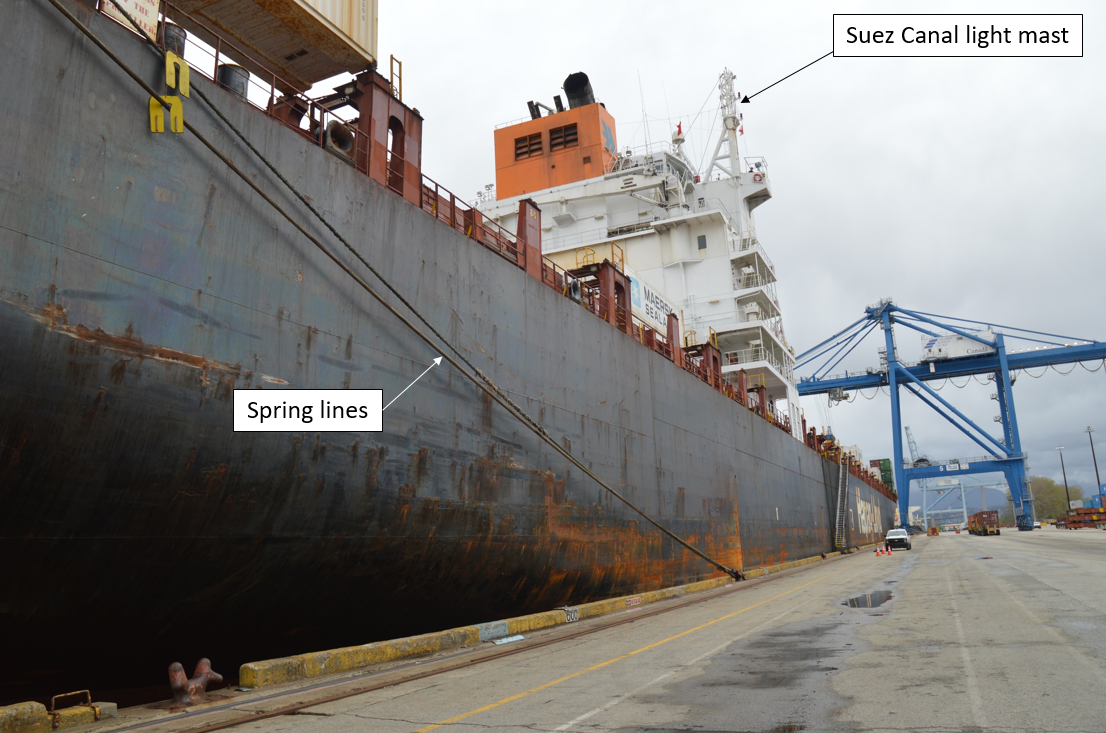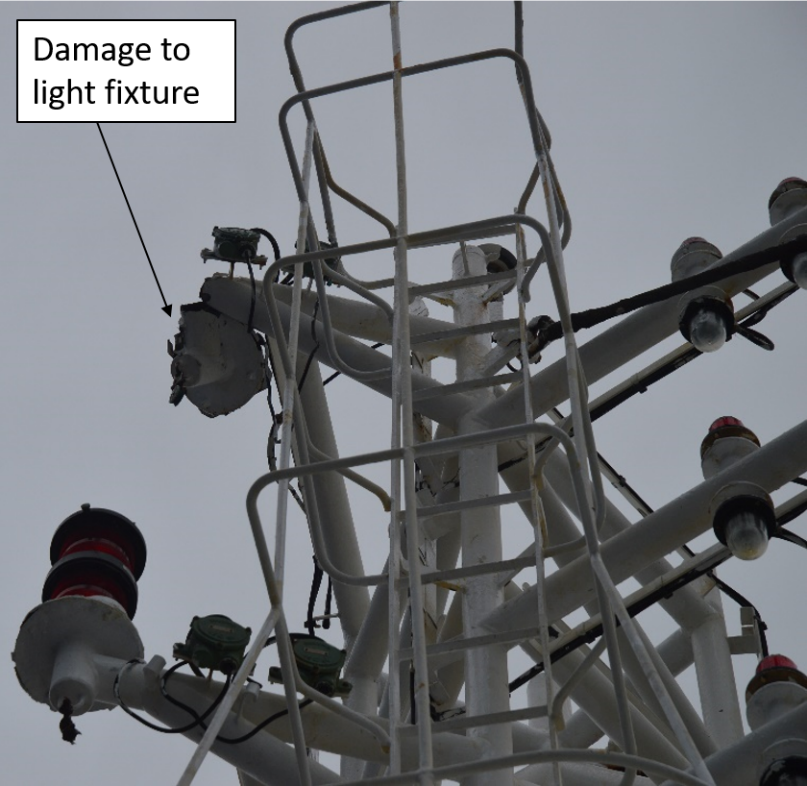Striking of shore crane
Container vessel Oakland Express
Fraser Surrey Docks, British Columbia
The Transportation Safety Board of Canada (TSB) investigated this occurrence for the purpose of advancing transportation safety. It is not the function of the Board to assign fault or determine civil or criminal liability. This report is not created for use in the context of legal, disciplinary or other proceedings. See Ownership and use of content. Masculine pronouns and position titles may be used to signify all genders to comply with the Canadian Transportation Accident Investigation and Safety Board Act (S.C. 1989, c. 3).
Description of the vessel
The Oakland Express is a 4890 TEUFootnote 1 fully cellular container vessel with a length overall of 294.04 m. The bridge and machinery / accommodation spaces are located approximately 70 m forward of the stern. The vessel has 36 twenty-foot container bays: 28 located forward of the accommodation and 8 located aft. The vessel is equipped with a voyage data recorder (VDR).Footnote 2
The vessel was constructed in 2000 in Korea by Hyundai Heavy Industries Ltd. and is one of 7 sister ships built for Hapag-Lloyd AG. In addition to a main mast on the vessel’s centreline, the Oakland Express and its sister vessels have another mast on their starboard side. At the top end of this mast is located the Suez Canal lightsFootnote 3 (Figure 1).
On the Oakland Express, the Suez Canal light mast extends 53.75 m above the keel. The outermost portion of the light fixtures on the mast are approximately 1 m inboard of the vessel’s starboard side. The majority of container vessels have Suez Canal lights incorporated into their main mast, which is typically located on the vessel’s centreline.
History of the voyage
At 1218Footnote 4 on 05 April 2019, the Oakland Express, en route from Seattle, Washington, U.S., to the Fraser Surrey DocksFootnote 5 in British Columbia, arrived at the Sand Heads pilot station at the entrance to the Fraser River. A Fraser River Pilot boarded and the master and pilot completed an information exchange. The master gave the vessel’s pilot card to the pilot.Footnote 6 The pilot card indicated the drafts as 7.5 m forward and 8.3 m aft, with a maximum air draftFootnote 7 of 46.0 m. No machinery deficiencies were reported, and the vessel was on hand steering. The pilot confirmed with the master that the vessel would proceed to berth 7 and explained that the vessel would berth starboard-side alongside with the assistance of 2 tugs. The pilot and master also discussed tidal and current information, as well as the anticipated weather conditions.Footnote 8
The vessel proceeded toward the Fraser Surrey Docks under the conduct of the pilot. At approximately 1424, tugs were secured forward and aft to assist with berthing. The mooring boatFootnote 9 told the pilot via very high frequency (VHF) radiotelephone that the vessel was to be berthed with the bow at the 380 m mark.Footnote 10 A linesman’s truck was parked at this location to assist the pilot in lining up the vessel’s bow.
The vessel was manoeuvred alongside the berth with the bow a few metres from the 380 m mark. The 1st line was ashore at 1448. Approximately 2 minutes later, the vessel was slowly moving ahead along the berth during final positioning, at which point one of the light fixtures on the Suez Canal light mast came into contact with the festoon railFootnote 11 on Crane 4.Footnote 12
The vessel was subsequently pulled off the berth with the assistance of the tugs. Crane 4 was repositioned clear of the vessel, and the vessel’s berthing position was modified. The vessel was moored with the bow at the 340 m mark at 1548.
The light fixture on the Suez Canal light mast sustained damage as a result of the striking (Figure 2), and the festoon rail on Crane 4 was bent over a distance of approximately 4 m and became misaligned with the horizontal section located under the beam (Figure 3).
Data on the VDR were not saved following the occurrence, which precluded the TSB from assessing that information.
Positioning of shore gantry cranes
At the time of the occurrence, 3 gantry cranes were positioned in the vicinity of berth 7 at the Fraser Surrey Docks. The gantry cranes are capable of transiting along the berth line on fixed tracks. Crane 3 was not operational on the day of the occurrence, and was positioned downriver at the far end of the berth for maintenance. Crane 4 was positioned around the 600 m mark to service containers in bays aft of the vessel’s accommodation. Crane 5 was positioned around the 450 m mark to service the bay forward of the accommodation space.
In March 2016, following instances where arriving or departing vessels were faced with a crane in a boom-down position, or the crane was left in a position where it could contact the bow or stern flare of a vessel, the Pacific Pilotage Authority issued a Notice to IndustryFootnote 13 reiterating the need for terminals to keep cranes at the midpoint or as far away from arriving or departing vessels as practicable and in the boom-up position.
Berthing plan
At Fraser Surrey Docks, the vessel’s final position at the berth is determined by the superintendents who are responsible for planning and supervising vessel operations at the terminal. The position is then passed on verbally to the head linesman, who in turn passes the information to the mooring boat by VHF radiotelephone and subsequently to the pilot as the vessel approaches the dock.
The superintendents had planned for the Oakland Express to be berthed with the bow at the 340 m mark (Figure 4). Crane 4 was to be positioned in the vicinity of the bays just aft of the accommodation in order to service these bays. This plan was conveyed verbally to the head linesman prior to the vessel’s arrival.
At the time of berthing, it was observed that the position of Crane 4 would impede running the aft spring lines from the vessel to the shore bollards. The head linesman amended the berthing position by 40 m to the 380 m mark to facilitate running the aft spring lines (Figure 5).Footnote 14
The amended position was passed on to the mooring boat and subsequently to the pilot by VHF radiotelephone. The amended position was not communicated to the superintendents, who were not present during the berthing. The amended berthing position resulted in the vessel’s Suez Canal light mast coming into contact with Crane 4.
Vertical restrictions at Fraser Surrey Docks
At the Fraser Surrey Docks, when the cranes are in the boom-up position, the booms are not perpendicular to the dock, but extend seaward at an angle of 10° (Figure 6). This results in a vertical restriction immediately adjacent to the berth of approximately 45.15 m.Footnote 15 Most conventional container vessels do not have a mast near the side of the ship and are not impeded by this restriction. However, the restriction does affect the Oakland Express and its sister vessels when they are berthed starboard-side alongside because of the proximity of the Suez Canal light mast to the side of the ship.
The Oakland Express and its sister vessels have called at the Fraser Surrey Docks on 42 occasions in the past 10 years. The terminal had previously identified that the gantry cranes cannot transit past the accommodation area on these vessels if they are starboard-side alongside. The terminal had created a safe work procedure for this process. When it is necessary to have a crane transit past the accommodation, the procedure is to list the vessel to port by approximately 1 to 2 degrees and have personnel monitor clearances on board while the crane is transiting. The procedure does not identify the potential for contact during berthing or unberthing.
Safety action taken
After the occurrence, the terminal
- revised the procedure for crane positioning prior to berthing and unberthing vessels,
- initiated a requirement for the superintendents to be present at the berth and equipped with VHF radiotelephones to communicate with pilots for all vessel movements,
- reviewed the incident with the Fraser River pilots and commenced bi-annual meetings to discuss areas of improvements and future plans, and
- revised the procedure for when a crane is passing a vessel’s mast or superstructure while transiting along the berth.
Safety messages
It is important that terminals identify hazards and mitigate all risks while developing and executing berthing plans. Pilots and terminal operators must take into account the specific particularites of a vessel and guidance issued by pilotage authorities.
The Oakland Express and its sister vessels have a special consideration with respect to air draft because of the proximity of the Suez Canal light mast to their shipside. Masters on these vessels must be mindful of this consideration and proactively share this information with pilots and terminals.
This report concludes the Transportation Safety Board of Canada’s investigation into this occurrence. The Board authorized the release of this report on . It was officially released on .





